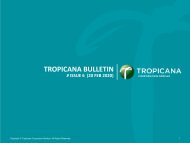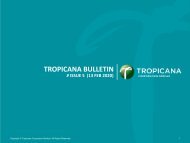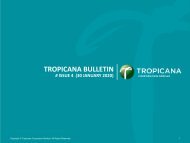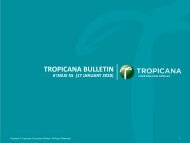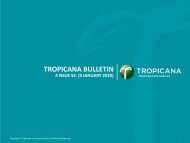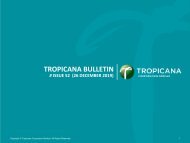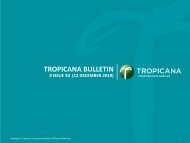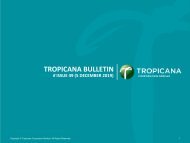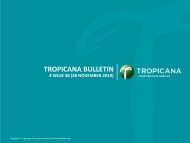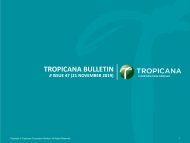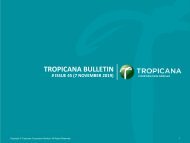Tropicana Magazine Mar-Apr 2018 #117: Edge Of Excitement
MARCH into April with the Edge of Excitement: Featuring the power couple of sustainability, legendary dancer Datuk Ramli Ibrahim, and the swanky bars of Singapore. Read it here now:
MARCH into April with the Edge of Excitement: Featuring the power couple of sustainability, legendary dancer Datuk Ramli Ibrahim, and the swanky bars of Singapore. Read it here now:
You also want an ePaper? Increase the reach of your titles
YUMPU automatically turns print PDFs into web optimized ePapers that Google loves.
HEALTH | THE SUSTAINABLE DIET<br />
Sports drinks<br />
Sports drinks are easy to take in.<br />
Consuming beverages containing<br />
electrolytes and carbohydrates can<br />
provide benefits over water alone. These<br />
drinks help replace minerals lost through<br />
perspiration while keeping you hydrated<br />
at the same time. Based on experts’<br />
opinion, 180 to 240 millilitres of glucoseelectrolyte<br />
solution containing 6 to 10% of<br />
carbohydrates is recommended at 10- to<br />
15-minute intervals.<br />
Gels<br />
Gels have an advantage over sports drinks<br />
as they are more energy-dense and can<br />
replenish higher levels of carbohydrates<br />
and electrolytes per feeding. Despite this<br />
efficiency, runners who rely on them should<br />
also remember to rehydrate as gels do not<br />
address this need.<br />
Sweets<br />
Eating jelly beans or gummy bears may work for some runners as these are<br />
considerably tastier than gels, bars or drinks. However, this mode of nutrient<br />
delivery is slower and less nutritious, so why bother? The simple answer is<br />
gratification. During a long distance run, it helps to have a tasty treat to look<br />
forward to during the last few clicks and if you’re 15 to 20 minutes away from the<br />
finish line, they’ll make a great pick-me-up.<br />
Sports bars<br />
Sports bars are energy-dense and pack<br />
the most carbohydrates, proteins and<br />
micronutrients. However, they may not be<br />
a practical choice for high intensity events<br />
as solids tend to increase the likelihood<br />
of a gastrointestinal upset. Many sports<br />
bars include protein, which may not be<br />
important to drive performance during<br />
your run but will help accelerate the<br />
recovery process if you consume it right<br />
after.<br />
POST-RUN<br />
Your post-run goal should be recovery. When done right, not only are your<br />
glycogen stores, fluids and electrolytes replenished, but protein synthesis can<br />
also be optimised to repair damaged muscle tissue. The tip is not to wait too long<br />
after the race to refuel. A study at the University of Texas found that the body<br />
replenishes glycogen at three times the normal rate immediately after exercise<br />
and this rate slows as the clock ticks. So if “speedy recovery” is what you are<br />
looking for, consume a recovery drink or a recovery sports bar with a 4:1 ratio of<br />
carbohydrates to protein within 30 minutes after picking up your finishers tee and<br />
medal.<br />
One last thought: whether your choice of fuelling is via a fruit or sports bar,<br />
drink or gel, it is always a good idea to test the product while training so that you<br />
know what to expect on the actual day. Sure, you can take advice and refuelling<br />
cues from your running buddies, but exact calorie needs vary from person to<br />
person. Experiment with what works best for your own body and remember that<br />
practise makes perfect.<br />
TM | MARCH/APRIL <strong>2018</strong><br />
86




